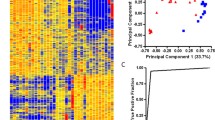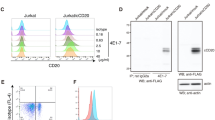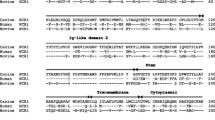Summary
Lymphoma in dogs resembles human non-Hodgkin's lymphoma in pathological presentation, immunophenotype, and response to therapy, thus representing a good model for comparative studies with human disease. Monoclonal antibodies (MAbs) were derived from mice immunized with a dog lymphoma cell line. Three MAbs were selected for further application in immunophenotyping and immunotherapy. The binding specificities, antigen characterization, and isotypes for these MAbs are described.
Similar content being viewed by others
References
Akiyama Y, Lubeck MD, Steplewski Z, Koprowski H (1984) Induction of mouse IgG2a and IgG3 dependent cellular cytotoxicity in human monocytic cells (U937) by human interferon. Cancer Res 44:5127–5131
Applebaum FR, Sale GE, Storb R, Charrier K, Deeg H-J, Graham T, Wulff JC (1984) Phenotyping of canine lymphoma with monoclonal antibodies, directed to cell surface antigens: classification, morphology, clinical presentation and response to chemotherapy. Hemato Oncol 2:151–168
Atkinson BF, Ernst CS, Herlyn M, Steplewski Z, Sears HF, Koprowski H (1982) Gastrointestinal cancer-associated antigen in immunoperoxidase assay. Cancer Res 42:4820–4823
Bayum A (1964) Separation of white blood cells. Nature 204:793–794
Bloomfield CD, Gajl-Peczalska KJ, Frizzera G, Kersey JH, Goldman AI (1979) Clinical utility of lymphocyte surface markers combined with the Luker-Collina histologic classifications in adult lymphoma. N Engl J Med 301:512–518
Carter RF, Valli VEO, Lumsden JH (1986) The cytology, histology and prevalence of cell types in canine lymphoma classified according to the National Cancer Institute Working Formulation. Can J Vet Res 50:154–164
Deeg H-J, Wulff CJ, DeRose S, Sale GE, Braun M, Brown MA, Springmeyer SC, Martin PJ, Storb R (1982) Unusual distribution of Ia-like antigens on canine lymphocytes. Immunogenetics 16:445–457
Dorn CR, Taylor DO, Hibbard HH (1967) Epizootiologic characteristics of canine and feline leukemia and lymphoma. Am J Vet Res 28:993–1001
Engvall E, Perlmann P (1971) Enzyme-linked immunosorbent assay (ELISA). Quantitative assay of immunoglobulin G. Immunochemistry 8:871–874
Hansen JA, Martin PJ, Nowinski RC (1980) Monoclonal antibodies identifying a novel T-cell antigen and Ia antigens of human lymphocytes. Immunogenetics 10:247–260
Hansson GC, Karlsson K-A, Larson G, McKibbin JM, Blaszczyk M, Herlyn M, Steplewski Z, Koprowski H (1983) Mouse monoclonal antibodies against cancer cell lines with specificities for blood group and related antigens. J Biol Chem 258:4091–4097
Herlyn D, Koprowsky H (1982) IgG2a monoclonal antibodies inhibit human growth through interaction with effector cells. Proc Natl Acad Sci USA 79:4761–4765
Hester JP, Kellogg RM, Mulzet AP, Kruger VR, McCredie KB, Freireich EJ (1979) Principles of blood separation and component extraction in a disposable continuous-flow singlestage channel. Blood 54:254–266
Hsu S-M, Raine L (1981) Protein A, avidin and biotin in immunohistochemistry. J Histochem Cytochem 29:1349–1353
Jeglum KA (1983) Chemotherapy of lymphosarcoma. In: Kirk RW (ed) Kirk's current therapy — small animal practice VIII, WB Saunders, Philadelphia, Pa.
Karlsson K-A, Samuelsson DE, Steen GO (1973) The sphingolipid composition of bovine kidney, cortex, medulla, and papilla. Biochim Biophys Acta 316:317–335
Kearney JF, Radburch A, Liesegan B, Rajewsky K (1979) A new mouse myeloma cell line that has lost immunoglobulin expression but permits the construction of antibody-secreting hybrid cell lines. J Immunol 123:1548–1550
Kohler G, Milstein C (1975) Continuous cultures of fused cells secreting antibody of predefined specificity. Nature 256:495–496
Koprowski H, Gerhard W, Croce CM (1977) Production of antibodies against influenza virus by somatic cell hybrids between mouse myeloma and primed spleen cells. Proc Natl Acad Sci USA 74:2985–2988
Koprowski H, Steplewski Z, Herlyn D, Herlyn M (1978) Study of antibodies against human melanoma produced by somatic cell hybrids. Proc Natl Acad Sci USA 75:3405–3409
Krawiec DR, Muscoplat CC (1984) Development and characterization of a hybridoma-derived antibody (Aby 1A1) with specificity to canine lymphocytes and peripheral T thymocytes. Am J Vet Res 45:491–198
Kung PC, Goldstein G, Reinherz E, Schlossman SD (1979) Monoclonal antibodies defining distinctive human T cell surface antigens. Sceince 206:347–349
Ladiges WC, Durkopp N, Urban C, Wulff JC, Storb R (1984) Monoclonal antibodies to canine cell surface antigens. A comparison of screening assays. Hybridoma 3:387–390
Laemmli UK (1970) Cleavage of structural proteins during the assembly of the head of bacteriophage T4. Nature 227:680–685
Lehtonen OP, Viljanen MK (1980) Antigen attachment in ELISA. J Immunol Methods 34:61–70
Macewen EC, Brown NO, Patnaik AK (1981) Cyclic combination chemotherapy of canine lymphosarcoma. J Am Vet Med Assoc 178:1178–1181
McKenzie JL, Fabre JW (1981) Studies with a monoclonal antibody on the distribution of Thy-1 in the lymphoid and extracellular connective tissue of the dog. Transplantation 31:275–282
Mitchell KF, Fuhrer JP, Steplewski Z, Koprowski H (1981) Structural characterization of the “melanoma-specific” antigen detected by monoclonal antibody 691 I5NU-4-B Mol. Immunology 18:207–218
Reinherz EL, Kung PC, Goldstein G, Schlossman SF (1979) Separation of functional subsets of human T cells by a monoclonal antibody. Proc Natl Acad Sci USA 76:4061–4065
Shulman M, Wilde CD, Kohler G (1978) A better cell line for making hybridomas secreting specific antibodies. Nature 276:269–270
Spira G, Bargellesi A, Teillaud J, Scharff M (1984) The identification of monoclonal class switch variants by sib selection and an ELISA assay. J Immunol Methods 74:307–315
Steplewski Z, Herlyn D, Maul G, Koprowski H (1983) Hypothesis: macrophages as effector cells for human tumor destruction mediated by monoclonal antibody. Hybridoma 2:1–5
Stocker JW, Garotta G, Hausmann B, Trucco M, Ceppellini R (1979) Separation of human B cells bearing HLA-DR antigens using a monoclonal antibody rosetting method. Tissue Antigens 13:212–222
The Non-Hodgkin's Lymphoma Pathologic Classification Project (1982) National Cancer Institute sponsored study of classifications of non-Hodgkin's lymphomas. Summary and description of a working formulation for clinical usage. Cancer 49:2112–2135
Towbin H, Staehlein T, Gordon J (1979) Electrophoretic transfer of proteins from polyacrylamide gels to nitrocellulose sheets: procedure and some application. Proc Natl Acad Sci USA 76:4350–4354
Trucco MM, Stocker JW, Ceppellini R (1978) Monoclonal antibodies against human lymphocyte antigens. Nature 273:666–668
Wulff JC, Deeg H-J, Storb R (1982) A monoclonal antibody (DT-2) recognizing canine T-lymphocytes. Transplantation 33:616–620
Author information
Authors and Affiliations
Additional information
Supported by NCI grant CA-10815
Rights and permissions
About this article
Cite this article
Steplewski, Z., Jeglum, K.A., Rosales, C. et al. Canine lymphoma-associated antigens defined by murine monoclonal antibodies. Cancer Immunol Immunother 24, 197–201 (1987). https://doi.org/10.1007/BF00205629
Received:
Accepted:
Issue Date:
DOI: https://doi.org/10.1007/BF00205629




